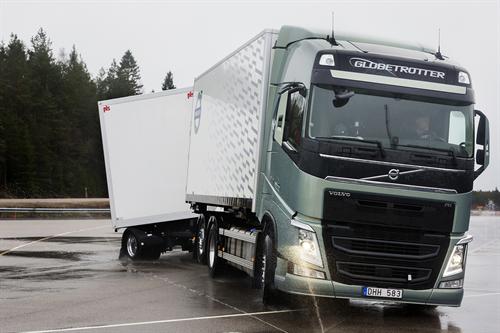 For trucks with conventional drawbar trailers, slippery winter roads and downhill gradients represent a tough challenge for even the most skilled of drivers. There is always the risk of the combination becoming unstable and, in the worst-case scenario, starting to jack-knife. Volvo Trucks has now developed a solution that significantly improves safety.
For trucks with conventional drawbar trailers, slippery winter roads and downhill gradients represent a tough challenge for even the most skilled of drivers. There is always the risk of the combination becoming unstable and, in the worst-case scenario, starting to jack-knife. Volvo Trucks has now developed a solution that significantly improves safety.
“Even if the truck driver ultimately manages to control the situation, it can be extremely unpleasant both for oncoming road users and the truck driver, if a combination suddenly veers off its intended course on a downhill gradient,” says Mats Sabelström, brake specialist for the Volvo Trucks brand.
In order to minimise the risk of this type of situation and potential accidents, Volvo Trucks has developed a system known as Stretch Brake that automatically brakes the trailer and straightens up the combination on slippery downhill stretches.
“About 15 per cent of the 30,000 serious road accidents in Europe every year involve trucks, in a slightly declining trend. With effective brakes, stability systems and collision warning systems we are already helping drivers avoid risky situations in difficult conditions. Stretch Brake is yet another important part of our long-term drive to increase traffic safety and minimise the number of accidents involving trucks,” says Carl Johan Almqvist, Traffic and Product Safety Director for the Volvo Trucks brand.
Stretch Brake is a complement to the combination’s electronic stability program (ESP) – yet another system that Volvo Trucks was the first truck maker in the world to introduce. While ESP is at its most effective at higher speeds, Stretch Brake is only operational at speeds below 40 km/h. Both systems contribute to better stability and easier steering.
“One might call Stretch Brake a kind of low-speed ESP. As the combination approaches a downhill slope, the driver manually activates the system. When the driver then releases the accelerator, the brakes on the trailer are automatically applied in a pulsated mode all the way down the hill until the gradient levels out and speed can be increased once again,” relates Mats Sabelström.
Stretch Brake was introduced in 2012 on Volvo FH trucks pulling conventional drawbar trailers and in 2013 on Volvo FM trucks pulling drawbar trailers. In 2014 it will also become available for Volvo FH and FM semi-trailer combinations.
“Drivers who have tested Stretch Brake came away very impressed with the system. As we now also introduce the system on tractor/semi-trailer combinations even more drivers will be able to negotiate difficult downhill gradients both more simply and safely,” says Carl Johan Almqvist.
According to the Volvo Trucks Accident Research Team, which specialises in studying traffic safety, about 60 or so of the truck accidents that occurred in Sweden alone last year could have been avoided with Stretch Brake2.
1Source: CARE 2011, CARE is the European centralized database on road accidents which result in death or injury across the EU.
2 Source: STRADA 2012, STRADA is a national (Swedish) information system collecting data of injuries and accidents in the entire road transport system. STRADA is based on information from the police as well as the hospitals.
Caption for images :
1. Jack-knifing occurs when the trailer slides forward and swings out, facing a different direction than the truck.
2. With a jack-knife situation, often the first indication a driver gets is when he sees the trailer sliding forward in his wing mirror.
3. The driver can activate the Stretch Brake system when driving on roads where there is a risk of jack-knifing, such as on downhill roads or on slippery, curvy roads.
4. Mats Sabelström, who works as a brake specialist for Volvo Trucks, has been involved in developing the new Stretch Brake system.
5. Carl Johan Almqvist, Traffic and Product Safety Director at Volvo Trucks.
